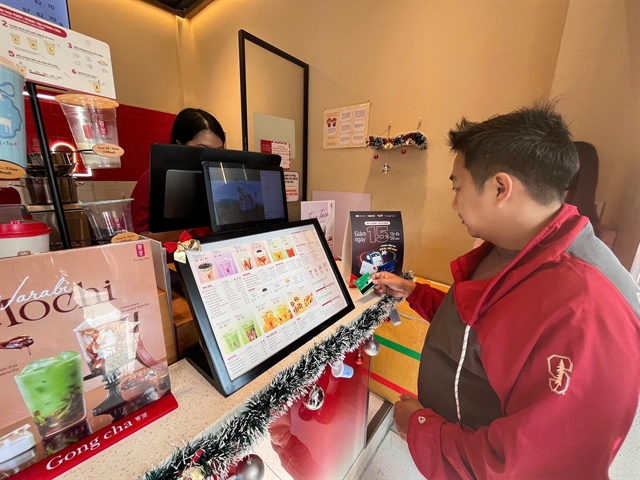 Sunday/Weekend
Sunday/Weekend

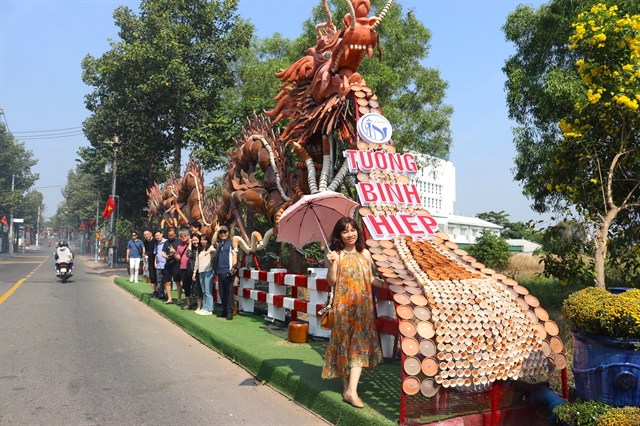 |
| This dragon statue made from clay pots and jugs in Bình Dương's Tương Bình Hiệp Ward is beloved by many locals and tourists alike. VNS Photo Việt Dũng |
by Việt Dũng
Bình Dương Province’s unique dragon statues made from clay pots and jugs, a viral sensation since late January, is not just a cool place for visitors to take fun photos, but also a brilliant way to promote one of the province’s most well-known traditional crafts – pottery.
A pair of earthly dragons can be found in Thủ Dầu Một City’s Tương Bình Hiệp Ward, each around 25m long and placed along the sides of Bà Sảng Bridge, which leads to the ward, a place also famous for traditional lacquer craft.
For days now locals and visitors have been flocking to this place to admire the dragon pair, carefully crafted using clay jugs and pots of various sizes and other objects with intricately designed details of dragon hair, teeth and claws.
Near the dragons, vibrant pottery items are also displayed and decorated with flowers in an eye-catching manner, coaxing travellers to stop by and enjoy the sight.
Trương Thị Kiều Trinh, deputy chairwoman of the ward People's Committee [administration], said since the ward is home to the famous Đại Hưng Pottery, a province-level heritage site, it wanted to do something unique for the Year of the Dragon and came up with the idea of the dragon statues made from assorted clay pots.
Its aim was to promote the heritage site and preserve the region's pottery craft, so it worked with the kiln on the project, and it took around six months for the dragons to be made, she said.
“We did not expect them to be so well received.”
Even as she was saying this, behind her were groups of people taking photos of the dragons with their friends, families and even pets.
Indeed, news of this unique work of art has captured the attention of visitors across the country and even from abroad as well.
Trần Thị Thanh Lộc, who lives in the ward, told Việt Nam News that she and other locals were very happy with this unique dragon duo.
She said many people enjoyed taking photos of the dragons and sharing them on social media, promoting craft village Tương Bình Hiệp, which is renowned for its lacquerware and pottery.
While the dragons have been very successful in drawing attention as a beautiful work of art, the bigger win for the locality is persuading many people to check out the place where they were made – the ancient Đại Hưng Pottery.
 |
| Đại Hưng Pottery is the oldest workshop where clay pots are made in the province. VNS Photo Việt Dũng |
Promoting a tradition
Đại Hưng Pottery has been around for 180 years, making it Bình Dương’s most ancient.
Since it is only around three kilometres from the dragon statues, many people visited the pottery after satisfying their urge to take photos.
It makes various types of clayware such as gardening pots, large vessels to store rice, water, rice wine and fish sauce.
These are items intertwined with Việt Nam’s culture and traditions.
Bùi Quốc Tuấn, the Đại Hưng Pottery manager, said: "As an ancient pottery with historical value, we receive plenty of tourists and visitors, including school and university students.
“We show them around the place and the process of pottery making, all the way to the final products."
Visitors can see potters working rhythmically with machinery to process clay, hand-shaping clay into jugs and pots, and coating them with glaze to give them a shiny surface.
They can also see up close the flaming hot kilns to which workers periodically feed wood to keep the fire at the right temperature.
The factory occasionally gets foreign tourists on experience trips.
In fact, everyone loves learning about pottery and the history and tradition associated with the craft.
In 2006 Đại Hưng Pottery was recognised as a province-level historical heritage site by the Bình Dương People’s Committee.
As an old traditional craft of Bình Dương, pottery is an important part of its cultural identity and even economic development, with several large pottery and ceramic companies exporting high-quality products to various countries around the world.
Bình Dương pottery was recognised as a national intangible cultural heritage in 2021.
Ceramics made in the province have appeared at many important and international events, including the 2017 APEC during which porcelain made by Minh Long was chosen to be given as national gifts to foreign leaders.
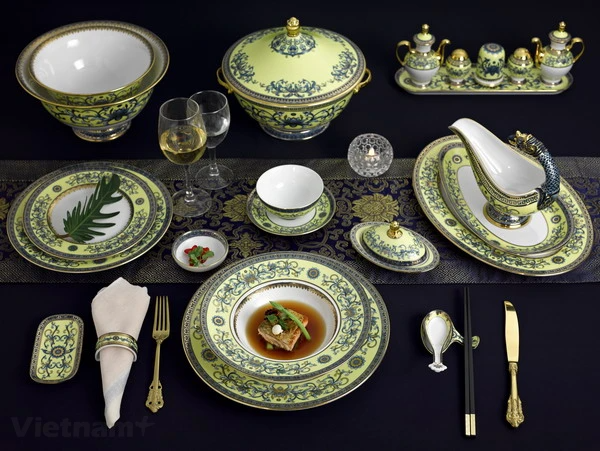 |
| Ceramic dinnerware from the province's Minh Long Ceramic Company was used to serve international leaders at APEC 2017. - Photo vietnamplus.vn |
Bình Dương has numerous pottery villages such as Lái Thiêu, Tân Phước Khánh and Chánh Nghĩa that also serve as tourist attractions.
The potteries there produce a wide variety of items, from common household goods to beautifully designed decorative pieces.
Local artisans have passed their craft down generations to keep their traditions alive.
Unfortunately, the number of potteries and businesses in Bình Dương has been dwindling over the years.
Many businesses are not keen on preserving this craft and have switched to more profitable industries.
There are many reasons for this decline, including rising material costs, competition from other domestic and foreign ceramic producers and young people preferring service jobs.
Manager Tuấn admitted that Đại Hưng Pottery's business had been slow in sluggish years, though COVID-19 and the recent economic downturn were also to blame.
At the start of the lunar year, usually a good period for the market, the province’s potteries have reported fewer orders than in previous years, and have drastically cut down on production.
One workshop said it had reduced the production of clay zodiac animal statues to around 1,000 from several thousands, while many others were not making them at all.
'The first of its kind'
Despite all the challenges, traditional pottery villages and businesses in the province are keeping the craft going.
For Tương Bình Hiệp Ward at least, this effort has paid off somewhat, with its pair of pottery dragons becoming a huge hit among locals and visitors and drawing people to the Đại Hưng Pottery.
"This initiative really plays a noticeable role in the promotion of the craft. While the idea of making mascot animals has been done many times before, I think making them using clay pots is definitely new and the first of its kind. So it really helped raise awareness of our pottery," Chairwoman Trinh said.
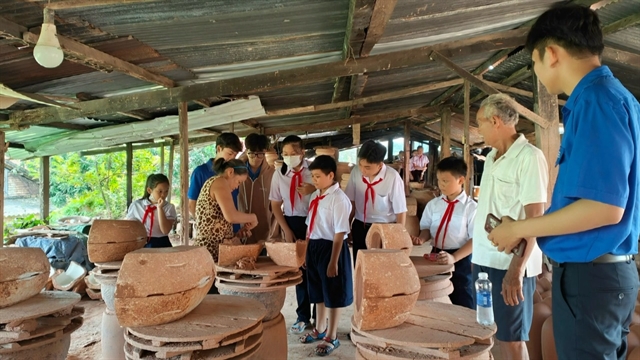 |
| Đại Hưng Pottery receives regular school field trips and tourist groups to educate visitors on the province's traditional craft and its history. Photo courtesy of Tương Bình Hiệp Ward's Youth Union |
Trinh also told Việt Nam News that her ward had been focusing on promoting the Đại Hưng Pottery, connecting it with universities and schools, who organise field trips so that their students would have a better appreciation of the ancient craft.
"Preserving traditional pottery offers numerous benefits in addition to maintaining cultural values and enriching art, such as fostering tourism, providing stable incomes to workers and helping train new ones, and supporting businesses," she said.
Meanwhile, Vườn Nhà Gốm (Pottery Home & Garden) in Thuận An City’s Lái Thiêu Ward organises pottery workshops to teach children and young people the craft.
Bình Dương Province is also focusing on preserving and developing pottery, holding many exhibitions and events to honour and promote the craft.
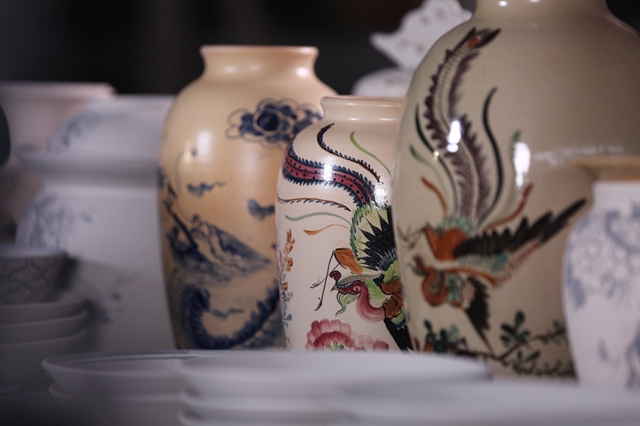 |
| Ceramic flower vases made in Lái Thiêu Pottery Village in Bình Dương. The province is making an effort to preserve this traditional craft. Photo courtesy of BEE Entertainment |
Hồ Trúc Thanh, deputy director of the province Department of Agriculture and Rural Development, said it was working on solutions and policies to support traditional pottery villages and trade facilitation programmes, and linking the villages with experience tourism.
Local pottery and ceramic businesses have been getting into specialised niches and seeking more raw material sources.
Traditional pottery kilns around Bình Dương have been accepting field trips that seek to educate people on the craft’s rich history.
According to experts, it is important to raise awareness of the craft among young generations, while the Government needs to have more conducive policies and focus more on promoting it with events like exhibitions and festivals to attract tourists and shoppers.
With steady support and initiatives from local authorities, and the efforts and creativity of businesses, one can hope that Bình Dương’s traditional pottery will one day return to its glory days instead of becoming just a memory. VNS




